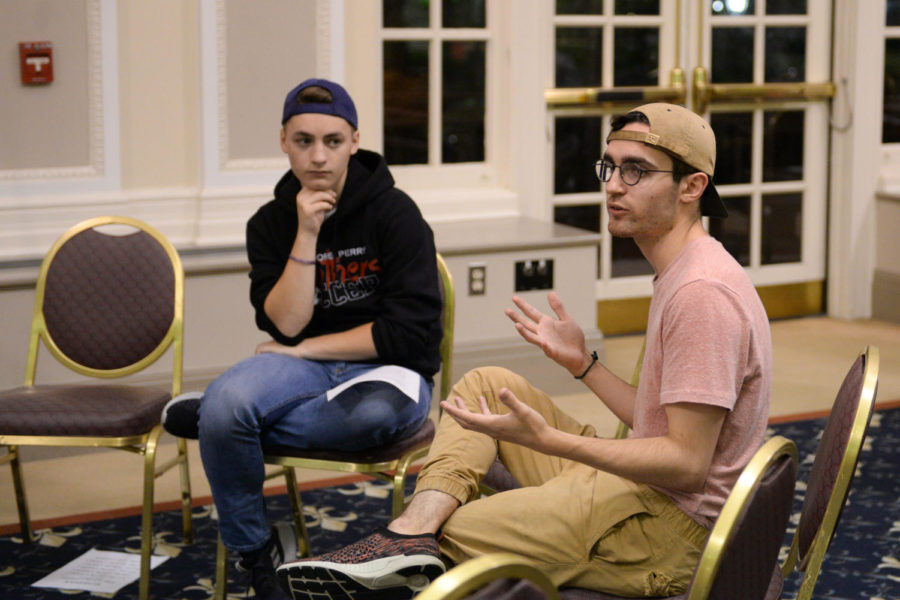Pay attention to all gun violence, not just mass shootings
Junior English writing major Jack Habib discusses suicide statistics at Wednesday night’s “Let’s Talk Gun Violence” event in the William Pitt Union. (Photo by Brian Gentry | Contributing Editor)
October 1, 2018
Based on mainstream media coverage, the public might think mass shootings are the only type of gun violence. After the 2017 Parkland High School shooting, The New York Times plastered tragic images of crying children on the homepage of its website. That same year, a shooting in Las Vegas killed 50 people — and CNN covered the details for hundreds of hours on its news program.
But while these shootings are tragic, they don’t represent the bulk of gun violence that takes place in America today. In reality, there are many different types of gun violence — mass shootings make up only a tiny percentage — and calling for simple, blanket solutions to such a multifaceted issue won’t solve anything, just exacerbate existing problems.
The UPTV nonpartisan political television show “The Bully PulPitt” sought to expand students’ views of gun violence on Wednesday night with its “Let’s Talk — Gun Violence” event in the William Pitt Union Lower Lounge. The discussion aimed to educate participants on gun violence in different settings, organized as domestic, police, mass shooting, homicide and suicide.
According to fivethirtyeight.com, a statistics website, suicides account for nearly two-thirds of gun deaths. Indiana implemented red flag laws to combat suicide in 2004 — allowing the state to confiscate guns from people who might be a danger to themselves or others — resulting in an 8 percent decrease in suicides since the law’s inception.
But there are better solutions to suicide outside of regulating guns themselves — 80 percent of suicide victims had untreated mental health disorders when they chose to end their lives. According to the National Institutes of Health, easy access to mental health services reduces suicide rates — but the Affordable Care Act cut mental health care funding, likely contributing to an uptick in recent suicides.
Still, even sweeping policies like red flag laws and health care expansion aren’t enough to significantly reduce gun violence — especially when gun violence manifests in certain demographics very differently.
“Race and class have a lot to do with gun violence, too,” Julia Schantz, a senior sociology and political science major, said in one of the group discussions. “It’s not just a gun control issue.”
While white middle-aged men are the most likely suicide victims, African Americans in racially segregated neighborhoods with low educational attainment and poverty are nearly 30 times more likely than white people to be victims of homicide — which accounts for one-third of gun deaths nationwide.
“Is this what we want America to be — where youngsters 7 years old are scared to death to go to school, and teenagers are in fact getting killed in schools?” Sen. Dianne Feinstein D-Calif said before Congress after a shooting at Parkland high school killed 17 students. “I don’t understand how if you want to do the right thing, why the right thing isn’t taking these [assault weapons] off the streets.”
But with homicides so concentrated in specific populations, blanket nationwide bans on assault rifles — as many Democrats in federal and state governments advocate — won’t work. The federal government implemented the ban in 1994 and then lifted it in 2004 because its resulting reduction in gun violence was “small at best and perhaps too small for reliable measurement,” according to a federally funded study. So instead of legislating gun control on a federal level, we need local, community-based solutions.
“Gun violence should be legislated on a local level,” Paul Anderson, a junior civil engineering student at Carnegie Mellon, said at the event. “That’s the way the constitution was intended. We shouldn’t have a nationwide assault weapons ban.”
In fact, like with suicides, the most effective solution to combating homicide has nothing to do with gun control at all — it’s an initiative called Operation Ceasefire, a collaborative effort between police, religious leaders and social scientists in Boston to reduce murder rates among black youth.
The organization focuses on the people committing murder instead of the guns themselves — issuing severe crackdowns on all members of murderous gangs and offering assistance to anyone who wanted to turn their life around. As a result, murder rates in Boston declined by 63 percent — and all other cities that have tried similar programs, like Stockton, California, and Indianapolis, have seen murder rates decline by at least 50 percent.
Implementing community policies like Operation Ceasefire also allows community members to have a closer relationship with police officers — which is extremely important since police brutality runs rampant in communities of color. While there are no official data on Operation Ceasefire’s effect on police brutality, improving community relations will likely humanize black lives in the eyes of law enforcement.
There’s no simple solution to gun violence in America, but certain methods are certainly more effective than others.
“The national conversation about mass shootings is just fear- and emotion- driven,” Cameron Hallihan, a junior neuroscience major, said at the event.
Merely clicking on articles and turning on the TV won’t solve the very real gun violence issues that communities face. Likewise, blanket, nationwide “solutions” fail to address the cultural and economic reasons why these issues exist in the first place.
Instead of inundating everyone’s news feed with gruesome images from mass shootings, the media should promote solutions that actually work — because saving lives is certainly newsworthy.








